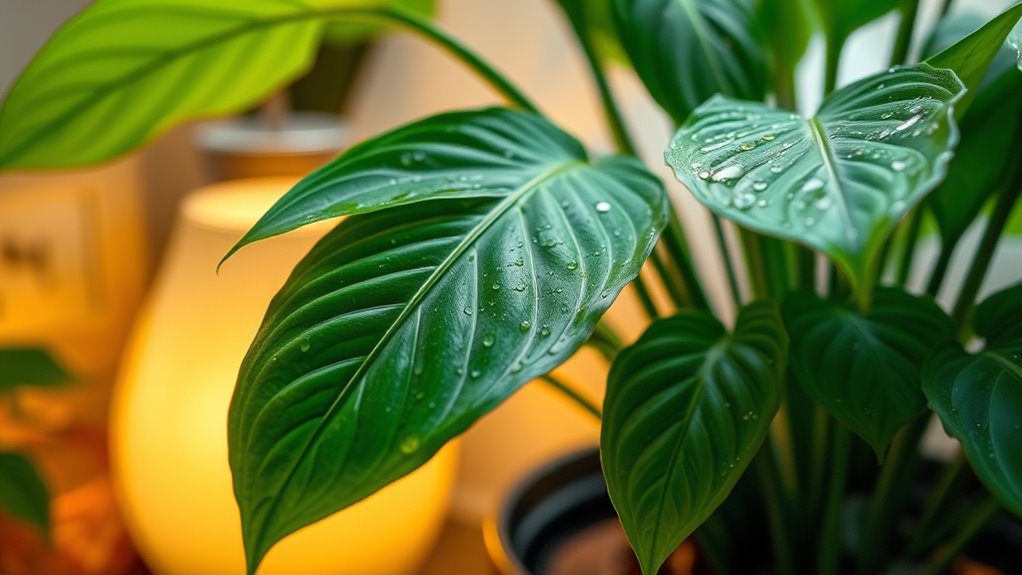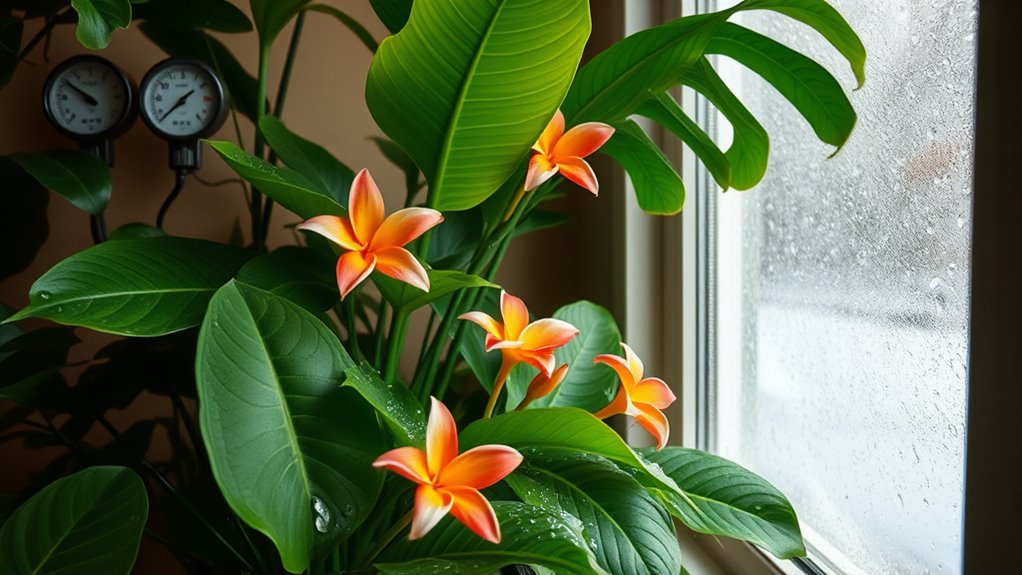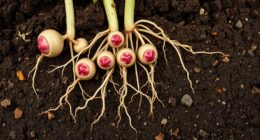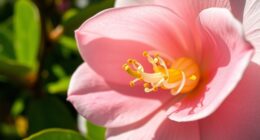To keep your tropical plants happy during dry winter air, increase local humidity by using a humidity tray with gravel and water, group plants together, and mist leaves regularly with room-temperature, distilled water. Consider investing in a humidifier and monitoring moisture levels with a hygrometer. Avoid placing plants near heat sources, and adjust watering routines to compensate for faster moisture loss. Want expert tips? Keep exploring these strategies to ensure your plants thrive all winter.
Key Takeaways
- Use humidity trays with pebbles and water, and group plants to boost local humidity levels.
- Regularly mist plants with room-temperature, distilled water to increase moisture and clean leaves.
- Employ a small, adjustable humidifier and monitor humidity with a hygrometer for consistent conditions.
- Adjust watering frequency based on soil moisture, ensuring proper drainage and avoiding overwatering.
- Keep plants away from heat sources and ensure good air circulation to prevent further drying and mold growth.

Winter can be tough on both your environment and your plans, but with a solid survival strategy, you can stay safe and comfortable. One of the biggest challenges during the colder months is the dry indoor air, especially if you keep your home heated constantly. Dry air can quickly sap moisture from your tropical plants, leading to brown leaf tips, wilting, and even plant death if you don’t take steps to counteract it. To keep your tropicals happy, you need to create a humid environment that mimics their natural habitat.
Start by placing a humidity tray beneath your plants. Fill a shallow tray with pebbles or gravel and add water until just below the top of the stones. As the water evaporates, it raises the local humidity around your plants without causing waterlogging. This simple trick can considerably improve air moisture levels and prevent your tropicals from drying out. If you have multiple plants, consider grouping them together. When plants are close, they create a microclimate with higher humidity, making the environment more comfortable for all of them. Just ensure there’s enough space between plants to promote air circulation and prevent mold.
Place a humidity tray under your plants and group them for a cozy, humid environment.
Another effective way to boost humidity is by misting your plants regularly. Use a spray bottle filled with room-temperature, distilled or filtered water to lightly mist your tropicals daily. This not only increases humidity but also helps remove dust from their leaves, encouraging healthy photosynthesis. Be cautious not to overdo it—excess moisture can promote fungal diseases. Besides misting, you might invest in a humidifier. A small, adjustable unit can maintain consistent humidity levels, especially if you have several tropical plants or a dedicated indoor garden. Just monitor the moisture levels with a hygrometer to ensure you don’t create overly damp conditions, which can be just as harmful.
In addition to humidity, pay attention to your plant’s watering schedule. Dry indoor air can cause your plants to lose moisture faster, so you may need to water more frequently. Check the top inch of soil; if it feels dry, give your plants a thorough soak, allowing excess water to drain freely. Remember to adjust watering based on the plant’s specific needs and the ambient humidity. Also, keep your plants away from direct heat sources like radiators or heating vents, which can dry the air even further and cause uneven water absorption.
Frequently Asked Questions
Can Tropical Plants Survive Indoor Heating Systems Long-Term?
Yes, tropical plants can survive indoor heating systems long-term if you take proper care. You should increase humidity around your plants using a humidifier, regularly misting, or placing a tray of water nearby. Keep the plants away from direct heat sources and make certain they receive enough light. Consistent watering and occasional fertilizing also help them thrive. With these steps, your tropicals will stay healthy despite dry indoor air.
What Are the Signs of Dehydration in Tropical Plants?
You’ll notice signs of dehydration in your tropical plants when their leaves start to wilt, curl, or turn brown at the edges. You might also see dry, brittle foliage or spots that look crispy. If the soil feels overly dry and the plant isn’t bouncing back after watering, it’s likely dehydrated. Keep an eye on these signs to act quickly and keep your tropicals healthy indoors.
How Often Should I Mist My Tropical Plants During Winter?
You should mist your tropical plants daily during winter, especially in dry indoor air, which can reduce humidity by up to 50%. Misting helps maintain moisture levels, preventing dehydration and leaf stress. If your home’s humidity drops below 40%, increase misting frequency. Use a fine spray to avoid overwatering and ensure good air circulation. Regular misting keeps your tropicals happy, lush, and healthy throughout the dry winter months.
Are There Specific Humidity Levels Ideal for Different Tropical Species?
You should aim for humidity levels between 60-80% for most tropical plants. However, some species like orchids thrive best at around 70-80%, while others like ferns prefer slightly higher humidity, near 80%. To keep them happy, monitor your plants regularly and adjust humidity accordingly. Using a humidifier or pebble trays can help maintain consistent levels, ensuring your tropicals stay healthy and vibrant throughout winter.
Can Using a Humidifier Harm My Tropical Plants?
Using a humidifier can harm your tropical plants if you don’t monitor the humidity levels carefully. Excess humidity may promote mold, mildew, or root rot, especially if your plants aren’t adapted to very moist conditions. To avoid these issues, use a hygrometer to keep humidity between the recommended levels for your specific plants, and make sure good air circulation. This way, you keep your tropicals healthy without risking harm.
Conclusion
By following these tips, you’ll keep your tropical plants thriving even in dry winter air. Did you know that indoor heating can reduce humidity levels by up to 30%, making it tougher for tropicals to survive? But with proper care—like regular misting and humidity trays—you can beat the odds. Stay proactive, and your tropicals will stay lush and healthy all season long. Remember, a little extra attention goes a long way!










